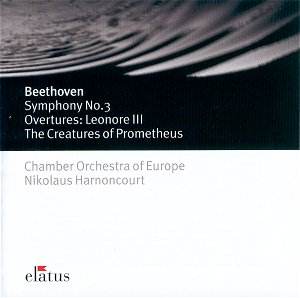Having been bitterly disappointed by Harnoncourt's
Beethoven symphonies numbers 4 and 5, (see
review) I was somewhat hesitant to listen to his Eroica particularly
as I rank the Eroica as the first great symphony and I do not
think anything will compare with Norrington's superlative version
(see review). I still
adhere to that view very strongly.
But Harnoncourt's opening movement of the Eroica
is hugely enjoyable. It is more reserved than Norrington but it
is a thoroughly musical performance and has a controlled excitement.
The sound is better than on the fourth and fifth symphonies although
I would have preferred more attack from the lower instruments
and the timpani. Harnoncourt's reading is different from Norrington’s
but equally logical. Perhaps the epic nature of this truly great
symphony appeals to Harnoncourt. He builds the music up as if
he were the master builder. It is very convincing and there is
a very surprising tenderness in some of the quiet passages. Extraordinary
but revealing! The performance seems quicker than Norrington but
it is 11 seconds slower at 15'57.
I am mystified as to how this symphony is, in
the main, beautifully played, whereas the same performers are
so amiss in symphonies 4 and 5.
Harnoncourt's tempo for the funeral march is
slower than Norrington at 14'37 compared with 12'18. Over two
minutes slower and it does not have the sinister quality of Norrington
with the welcome emphasis on the triplet grace notes on the basses.
Harnoncourt's performance is exquisitely sad and emotional but
not in a banal sense. It is quite beautiful, lovingly played and
conducted. He has the tragic element and it is very moving. But
a slow movement has to maintain interest and not wear out its
welcome. Perhaps Beethoven made it a little too long but Harnoncourt
gives us much to think about and his tenderness is touching. He
seems to be wearing his heart on his sleeve.
But he captures some grim moments as well.
Whereas Norrington leans towards the lively baroque
style Harnoncourt is nearer to the romantic school. Perhaps neither
are right stylistically.
The scherzo starts as a whisper, as it should,
with some superb playing. The tempo is right and I admire the
articulation in the more powerful passages. I noted some hesitation
in the trio.
The finale is the least successful movement.
Harnoncourt is two minutes slower than Norrington but he does
find a stately pageantry in the music that may call for it. Harnoncourt
plays it well but it does not have Norrington's excitement of
energy. The coda is a bit wimpish at first!
I can best sum this up but saying that if the
Norrington version did not exist I would be happy with Harnoncourt.
Even so, I will play the Harnoncourt again.
I have always been fascinated by the woman in
his life, his immortal beloved and have often thought his portraits
of her are in his opera Fidelio. Is Leonora his immortal beloved
in music just as Steffi Geyer is in Bartók's Violin Concerto
no. 1 and Manon Gropius in Berg's Violin Concerto? In Leonora
number 3 we have an exciting and dignified woman and an inflamed
desire for her.
I did not respond to this performance. The episodic
nature of the piece needs a tighter control, I think. It is not
an easy piece to bring off and the operatic content with trumpets
off-stage does not lend itself so well to the concert hall or
the recording studio as to the opera itself. But the main theme
is gorgeous (Leonora herself). The coda is a little too heavy
but there is a terrific final drum roll!
The Creatures of Prometheus is a good overture
but not too convincing here. It needs more drive and commitment.
David C F Wright
